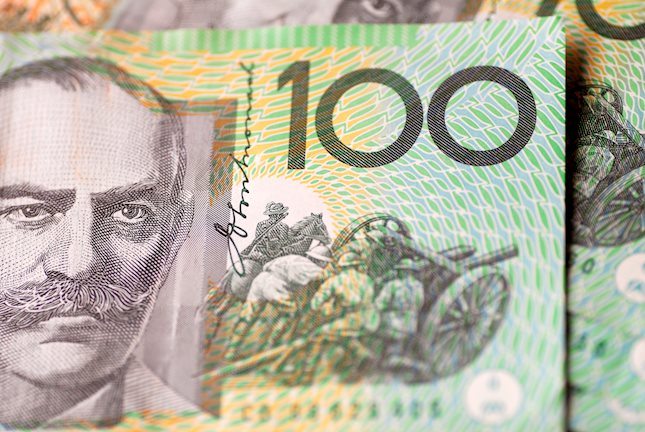- Gold edges lower near multi-week lows on Monday amid reduced Fed rate cut bets.
- The stronger US NFP report suggests that the Fed might delay starting its rate-cutting cycle.
- The focus shifts to the US consumer inflation figures and the FOMC decision on Wednesday.
Gold price (XAU/USD) enters a bearish consolidation phase and oscillates in a range near its lowest level in over a month, below the $2,300 mark during the early European session on Monday. The popularly known Nonfarm Payrolls (NFP) report showed that the world's largest economy created a lot more jobs than expected in May, forcing investors to scale back their bets for a September interest rate cut by the Federal Reserve (Fed). This keeps US Treasury bond yields elevated and lifts the US Dollar (USD) to a nearly one-month high, which, in turn, is seen acting as a headwind for the non-yielding yellow metal.
Furthermore, reports that the People's Bank of China (PBoC) paused gold purchases to its reserves in May, ending a massive buying spree that ran for 18 months, further seem to undermine the Gold price. That said, a cautious market mood lends some support to the safe-haven XAU/USD and helps limit deeper losses. Traders also seem reluctant to place aggressive directional bets ahead of this week's key US data and central bank event risk—the release of the latest US consumer inflation figures and the outcome of the two-day FOMC policy meeting on Wednesday. This, in turn, warrants caution before positioning for further losses.
Daily Digest Market Movers: Gold price struggles to lure buyers amid reduced Fed rate cut bets, bullish USD
- The upbeat US employment details released on Friday fueled speculations that the Federal Reserve could delay the start of the rate-cutting cycle, which, in turn, is seen capping the upside for the non-yielding Gold price.
- The headline NFP showed that the US economy added 272K jobs in May as compared to the 185K anticipated and the previous month's upwardly revised 175K, overshadowing an uptick in the unemployment rate to 4.0%.
- Furthermore, Average Hourly Earnings surpassed consensus estimates and increased by 4.1% during the 12 months through May, which might push up prices and require the Fed to keep interest rates higher for longer.
- The yield on the benchmark 10-year US government bond jumped to 4.45% after the data, while the rate-sensitive 2-year yield remains close to 5.0%, underpinning the US Dollar and acting as a headwind for the XAU/USD.
- Meanwhile, the People's Bank of China (PBoC) snapped 18 months of continuous Gold buying in May, raising concern about decreasing demand for the bullion in one of the world’s biggest buyers and favoring bearish traders.
- Investors, however, prefer to wait on the sidelines ahead of this week's release of the latest US consumer inflation figures and the highly-anticipated FOMC monetary policy decision on Wednesday before placing directional bets.
- The chances of a rate cut in September fell to around 50% following the US jobs data, from around 70% on Thursday, and the markets are now pricing in just one cut of 25 basis points this year, either in November or December.
- Hence, investors will look for fresh signals on when the Fed will begin cutting interest rates amid the still resilient US economy, which will play a key role in determining the next leg of a directional move for the commodity.
Technical Analysis: Gold price bears have the upper hand below 50-day SMA support breakpoint and the $2,300 level
From a technical perspective, Friday's close below the 50-day Simple Moving Average (SMA) and a subsequent breakdown through the $2,300 mark could be seen as a fresh trigger for bearish traders. Moreover, oscillators on the daily chart have been gaining negative traction and suggest that the path of least resistance for the Gold price is to the downside. Some follow-through selling below the $2,285 horizontal support will reaffirm the bearish outlook and expose the next relevant support near the $2,254-2,253 region. The downward trajectory could extend further towards the $2,225-2,220 area en route to the $2,200 round figure.
On the flip side, any attempted recovery might now confront stiff resistance near the $2,325 horizontal zone ahead of the 50-day SMA support breakpoint, currently pegged near the $2,343-2,344 region. This is followed by the $2,360-2,362 supply zone, which if cleared decisively should allow the Gold price to retest last week’s swing high, around the $2,387-2,388 area and reclaim the $2,400 mark. A sustained strength beyond the latter will negate any near-term negative bias and pave the way for some meaningful near-term appreciating move.
US Dollar price in the last 7 days
The table below shows the percentage change of US Dollar (USD) against listed major currencies in the last 7 days. US Dollar was the strongest against the Canadian Dollar.
| USD | EUR | GBP | CAD | AUD | JPY | NZD | CHF | |
| USD | 0.91% | 0.25% | 1.04% | 0.94% | -0.03% | 0.67% | -0.40% | |
| EUR | -0.91% | -0.66% | 0.13% | 0.03% | -0.94% | -0.24% | -1.31% | |
| GBP | -0.25% | 0.65% | 0.79% | 0.68% | -0.27% | 0.42% | -0.65% | |
| CAD | -1.05% | -0.13% | -0.80% | -0.11% | -1.07% | -0.37% | -1.44% | |
| AUD | -0.96% | -0.03% | -0.69% | 0.11% | -0.95% | -0.27% | -1.34% | |
| JPY | 0.03% | 0.94% | 0.28% | 1.05% | 0.92% | 0.69% | -0.37% | |
| NZD | -0.67% | 0.24% | -0.40% | 0.38% | 0.28% | -0.69% | -1.07% | |
| CHF | 0.39% | 1.29% | 0.64% | 1.42% | 1.32% | 0.37% | 1.06% |
The heat map shows percentage changes of major currencies against each other. The base currency is picked from the left column, while the quote currency is picked from the top row. For example, if you pick the Euro from the left column and move along the horizontal line to the Japanese Yen, the percentage change displayed in the box will represent EUR (base)/JPY (quote).
Gold FAQs
Gold has played a key role in human’s history as it has been widely used as a store of value and medium of exchange. Currently, apart from its shine and usage for jewelry, the precious metal is widely seen as a safe-haven asset, meaning that it is considered a good investment during turbulent times. Gold is also widely seen as a hedge against inflation and against depreciating currencies as it doesn’t rely on any specific issuer or government.
Central banks are the biggest Gold holders. In their aim to support their currencies in turbulent times, central banks tend to diversify their reserves and buy Gold to improve the perceived strength of the economy and the currency. High Gold reserves can be a source of trust for a country’s solvency. Central banks added 1,136 tonnes of Gold worth around $70 billion to their reserves in 2022, according to data from the World Gold Council. This is the highest yearly purchase since records began. Central banks from emerging economies such as China, India and Turkey are quickly increasing their Gold reserves.
Gold has an inverse correlation with the US Dollar and US Treasuries, which are both major reserve and safe-haven assets. When the Dollar depreciates, Gold tends to rise, enabling investors and central banks to diversify their assets in turbulent times. Gold is also inversely correlated with risk assets. A rally in the stock market tends to weaken Gold price, while sell-offs in riskier markets tend to favor the precious metal.
The price can move due to a wide range of factors. Geopolitical instability or fears of a deep recession can quickly make Gold price escalate due to its safe-haven status. As a yield-less asset, Gold tends to rise with lower interest rates, while higher cost of money usually weighs down on the yellow metal. Still, most moves depend on how the US Dollar (USD) behaves as the asset is priced in dollars (XAU/USD). A strong Dollar tends to keep the price of Gold controlled, whereas a weaker Dollar is likely to push Gold prices up.
Information on these pages contains forward-looking statements that involve risks and uncertainties. Markets and instruments profiled on this page are for informational purposes only and should not in any way come across as a recommendation to buy or sell in these assets. You should do your own thorough research before making any investment decisions. FXStreet does not in any way guarantee that this information is free from mistakes, errors, or material misstatements. It also does not guarantee that this information is of a timely nature. Investing in Open Markets involves a great deal of risk, including the loss of all or a portion of your investment, as well as emotional distress. All risks, losses and costs associated with investing, including total loss of principal, are your responsibility. The views and opinions expressed in this article are those of the authors and do not necessarily reflect the official policy or position of FXStreet nor its advertisers. The author will not be held responsible for information that is found at the end of links posted on this page.
If not otherwise explicitly mentioned in the body of the article, at the time of writing, the author has no position in any stock mentioned in this article and no business relationship with any company mentioned. The author has not received compensation for writing this article, other than from FXStreet.
FXStreet and the author do not provide personalized recommendations. The author makes no representations as to the accuracy, completeness, or suitability of this information. FXStreet and the author will not be liable for any errors, omissions or any losses, injuries or damages arising from this information and its display or use. Errors and omissions excepted.
The author and FXStreet are not registered investment advisors and nothing in this article is intended to be investment advice.
Recommended content
Editors’ Picks

AUD/USD hangs near multi-year low as traders await US NFP report
AUD/USD consolidates just above its lowest level since October 2022 as traders move to the sidelines ahead of Friday's release of the closely-watched US NFP report. In the meantime, rising bets for an early RBA rate cut, China's economic woes, US-China trade war fears, geopolitical risks and a softer risk tone act as a headwind for the Aussie.

USD/JPY bulls turn cautious near multi-month peak ahead of US NFP
USD/JPY moves little following the release of household spending data from Japan and remains close to a multi-month top amid wavering BoJ rate hike expectations. Furthermore, the recent widening of the US-Japan yield differential, bolstered by the Fed's hawkish shift, undermines the lower-yielding JPY and acts as a tailwind for the currency pair amid a bullish USD.

Gold price consolidates below multi-week top; looks to US NFP for fresh impetus
Gold price enters a bullish consolidation phase below a four-week top touched on Thursday as bulls await the US NFP report before placing fresh bets. In the meantime, geopolitical risks, trade war fears and a weaker risk tone might continue to act as a tailwind for the safe-haven XAU/USD.

Ripple's XRP plunges over 4% following funding rates decline
Ripple's XRP declined 4% on Friday following a decline in its funding rates. The remittance-based token could decline to test the $2.17 support level if the crypto market decline extends.

How to trade NFP, one of the most volatile events Premium
NFP is the acronym for Nonfarm Payrolls, arguably the most important economic data release in the world. The indicator, which provides a comprehensive snapshot of the health of the US labor market, is typically published on the first Friday of each month.

Best Forex Brokers with Low Spreads
VERIFIED Low spreads are crucial for reducing trading costs. Explore top Forex brokers offering competitive spreads and high leverage. Compare options for EUR/USD, GBP/USD, USD/JPY, and Gold.